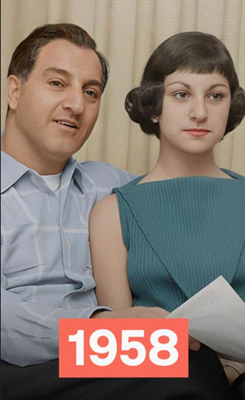
Marlo Thomas, born on November 21, 1937, in Detroit, Michigan, has long been celebrated as one of America’s most beloved actresses, philanthropists, and cultural icons.
Over the course of her career, she has embodied charm, intelligence, and beauty, winning the hearts of audiences not just for her on-screen performances, but for her embodiment of independence and modern womanhood.
From her early days as a young actress in New York to her iconic role in the groundbreaking 1968 television series “That Girl,” Thomas became synonymous with the idea of a woman forging her own path—single, successful, and unapologetically ambitious.
In an era when female characters were often relegated to supporting roles, Thomas’ portrayal of Ann Marie offered viewers a refreshing representation of self-reliance, ambition, and charm, helping redefine the television landscape forever.
From Screen Star to Cultural Icon
While many remember Marlo Thomas primarily for “That Girl,” her influence extended far beyond a single sitcom.
After the show ended in 1971, she continued to break new ground, notably with the 1972 television special Free to Be… You & Me, which encouraged individuality and challenged traditional gender norms for children.
Through music, storytelling, and performance, Thomas promoted self-expression and equality, leaving a lasting legacy that influenced generations.
Over the decades, she amassed numerous awards, including four Emmys, a Golden Globe, a Grammy, a Peabody Award, and induction into the Broadcasting and Cable Hall of Fame.
She has also been an outspoken advocate for philanthropy, particularly through her work with St. Jude Children’s Research Hospital, a cause deeply connected to her family.
Thomas’ career has been defined by more than awards or accolades; it has been characterized by a steadfast commitment to redefining expectations for women both on-screen and in society.
Her accomplishments established her as a trailblazer, a woman whose influence extended beyond entertainment into education, activism, and social reform.
Yet despite this remarkable record, public attention in recent years has increasingly centered not on her achievements, but on her appearance, particularly the noticeable changes in her facial features as she aged.

Public Fascination and the Question of Cosmetic Intervention
For decades, Marlo Thomas’ soft, expressive features were instantly recognizable—her smile brightened screens, her eyes conveyed warmth and intelligence, and her face reflected the vitality of a woman in the prime of her career.
However, in recent years, as Thomas entered her 80s, observers noted a transformation.
Her cheeks appeared fuller, her jawline more defined, and her skin smoother than what might be expected naturally at her age.

These changes prompted speculation about whether she had undergone cosmetic procedures, a question compounded by the modern culture of scrutiny surrounding female celebrities’ appearances.
Thomas has consistently denied having any plastic surgery. In 2008, when asked directly by the Hartford Courant, she stated: “I have never had plastic surgery, and wouldn’t.”
She credited her ageless appearance to regular exercise, particularly daily jogging, a positive outlook on life, and a commitment to happiness and wellness.
Despite these assurances, experts and fans alike have examined photographs over the years, noting differences that some interpret as signs of subtle cosmetic enhancement.
Analysts have suggested possibilities ranging from rhinoplasty to dermal fillers, Botox injections, and gentle facial lifts—procedures that can subtly alter contours without dramatically changing the individual’s fundamental appearance.
Social Media Reactions and Fan Observations
The discussion about Thomas’ appearance has been particularly pronounced on social media, where fans freely express their opinions, sometimes nostalgically recalling the “original” Marlo Thomas.
Many lament the perceived loss of her natural features, with comments like, “Her natural nose was perfect! Why did she change it?”
Others suggest that some alterations may have occurred long before the public noticed, noting subtle shifts in photographs from the 1970s and 1980s.
These conversations illustrate a cultural fascination with celebrity appearances, as well as the broader societal pressure on women—particularly those in the public eye—to maintain a youthful look, regardless of age.
AI Reconstructions and Reimagined Appearances
Recent advancements in artificial intelligence have allowed for a new exploration of Thomas’ visage.
Using AI-generated imagery, it is now possible to create reconstructions of Thomas’ face as it might have appeared without any cosmetic enhancements, compared side-by-side with contemporary photographs.
These AI renderings reveal a striking contrast: the AI versions portray her natural aging process with subtle skin texture, relaxed facial contours, and the gentle softening of features that occur over time.
In comparison, contemporary photographs show a smoother, lifted appearance with more defined cheeks, taut skin, and an overall symmetry that suggests intervention.

For instance, at the July 2024 premiere of The Fabulous Four, Thomas wore a black floral dress, radiating elegance with plump, lifted cheeks and smooth skin.
AI reconstruction of the same image restored natural aging textures, softening the jawline and introducing subtle lines that reflected her true age.
Similarly, at the 2015 Off-Broadway premiere of Clever Little Lies, the AI-generated image highlighted the natural fall of the cheeks and softened the lips, contrasting sharply with her taut, camera-ready real-life appearance.

Her 2023 appearance on the Today show in cobalt blue demonstrates a similar dichotomy:
while her on-screen visage appeared radiant, glossy, and symmetrical, the AI version suggested a more relaxed, natural aging process, providing a glimpse of what might have been.
Even her poised 2016 red carpet moment at the Broadway opening of The Father shows notable differences when reconstructed, with AI softening the brows, relaxing the smile, and adding realistic texture to the skin.
A Legacy That Transcends Appearances
Despite intense scrutiny of her physical appearance, Marlo Thomas’ enduring legacy lies far beyond superficial discussions. Her contributions to television, philanthropy, and cultural activism are monumental.
She changed how women were portrayed on screen, championed children’s rights and gender equality, and continues to inspire through her work with St. Jude Children’s Research Hospital.
AI reconstructions and cosmetic speculation may provide a lens for curiosity, but they cannot diminish her professional accomplishments or the profound impact she has had on American culture.
Thomas’ story is a reminder that aging, transformation, and even the public’s fascination with beauty cannot overshadow the enduring influence of a woman who broke boundaries and inspired generations.
Whether celebrated for her pioneering roles, her activism, or even the way she navigates public scrutiny, she remains a figure of grace, intellect, and achievement.
Her life illustrates the intersection of media scrutiny, cultural expectations, and personal resilience, highlighting the challenge of remaining authentic in an environment obsessed with appearances.
Ultimately, Marlo Thomas’ career and life serve as a testament to the power of perseverance, creativity, and social consciousness.
While speculation about cosmetic procedures may continue, the true story is one of enduring influence, cultural innovation, and personal dedication.
Her legacy is not defined by a single photograph, a smooth complexion, or a symmetrical jawline; it is defined by decades of meaningful work, groundbreaking achievements, and a life devoted to changing the world for the better.
As audiences continue to admire her work, her story reminds us that true impact is measured not by appearances, but by the lives we touch, the barriers we break, and the inspiration we leave behind.
Marlo Thomas stands today not only as a symbol of timeless beauty, but as a living example of what it means to shape culture, challenge norms, and remain unapologetically oneself, regardless of the pressures of fame or public opinion.
In a world obsessed with appearances, she exemplifies the enduring power of talent, heart, and integrity.
Her story encourages us to look beyond the surface and value the full measure of a person’s contributions—a lesson as relevant now as it was when she first stepped into the spotlight over six decades ago.
Marlo Thomas, born on November 21, 1937, in Detroit, Michigan, has long been celebrated as one of America’s most beloved actresses, philanthropists, and cultural icons.
Over the course of her career, she has embodied charm, intelligence, and beauty, winning the hearts of audiences not just for her on-screen performances, but for her embodiment of independence and modern womanhood.
From her early days as a young actress in New York to her iconic role in the groundbreaking 1968 television series “That Girl,” Thomas became synonymous with the idea of a woman forging her own path—single, successful, and unapologetically ambitious.
In an era when female characters were often relegated to supporting roles, Thomas’ portrayal of Ann Marie offered viewers a refreshing representation of self-reliance, ambition, and charm, helping redefine the television landscape forever.
From Screen Star to Cultural Icon
While many remember Marlo Thomas primarily for “That Girl,” her influence extended far beyond a single sitcom.
After the show ended in 1971, she continued to break new ground, notably with the 1972 television special Free to Be… You & Me, which encouraged individuality and challenged traditional gender norms for children.
Through music, storytelling, and performance, Thomas promoted self-expression and equality, leaving a lasting legacy that influenced generations.
Over the decades, she amassed numerous awards, including four Emmys, a Golden Globe, a Grammy, a Peabody Award, and induction into the Broadcasting and Cable Hall of Fame.
She has also been an outspoken advocate for philanthropy, particularly through her work with St. Jude Children’s Research Hospital, a cause deeply connected to her family.
Thomas’ career has been defined by more than awards or accolades; it has been characterized by a steadfast commitment to redefining expectations for women both on-screen and in society.
Her accomplishments established her as a trailblazer, a woman whose influence extended beyond entertainment into education, activism, and social reform.
Yet despite this remarkable record, public attention in recent years has increasingly centered not on her achievements, but on her appearance, particularly the noticeable changes in her facial features as she aged.

Public Fascination and the Question of Cosmetic Intervention
For decades, Marlo Thomas’ soft, expressive features were instantly recognizable—her smile brightened screens, her eyes conveyed warmth and intelligence, and her face reflected the vitality of a woman in the prime of her career.
However, in recent years, as Thomas entered her 80s, observers noted a transformation.
Her cheeks appeared fuller, her jawline more defined, and her skin smoother than what might be expected naturally at her age.

These changes prompted speculation about whether she had undergone cosmetic procedures, a question compounded by the modern culture of scrutiny surrounding female celebrities’ appearances.
Thomas has consistently denied having any plastic surgery. In 2008, when asked directly by the Hartford Courant, she stated: “I have never had plastic surgery, and wouldn’t.”
She credited her ageless appearance to regular exercise, particularly daily jogging, a positive outlook on life, and a commitment to happiness and wellness.
Despite these assurances, experts and fans alike have examined photographs over the years, noting differences that some interpret as signs of subtle cosmetic enhancement.
Analysts have suggested possibilities ranging from rhinoplasty to dermal fillers, Botox injections, and gentle facial lifts—procedures that can subtly alter contours without dramatically changing the individual’s fundamental appearance.
Social Media Reactions and Fan Observations
The discussion about Thomas’ appearance has been particularly pronounced on social media, where fans freely express their opinions, sometimes nostalgically recalling the “original” Marlo Thomas.
Many lament the perceived loss of her natural features, with comments like, “Her natural nose was perfect! Why did she change it?”
Others suggest that some alterations may have occurred long before the public noticed, noting subtle shifts in photographs from the 1970s and 1980s.
These conversations illustrate a cultural fascination with celebrity appearances, as well as the broader societal pressure on women—particularly those in the public eye—to maintain a youthful look, regardless of age.
AI Reconstructions and Reimagined Appearances
Recent advancements in artificial intelligence have allowed for a new exploration of Thomas’ visage.
Using AI-generated imagery, it is now possible to create reconstructions of Thomas’ face as it might have appeared without any cosmetic enhancements, compared side-by-side with contemporary photographs.
These AI renderings reveal a striking contrast: the AI versions portray her natural aging process with subtle skin texture, relaxed facial contours, and the gentle softening of features that occur over time.
In comparison, contemporary photographs show a smoother, lifted appearance with more defined cheeks, taut skin, and an overall symmetry that suggests intervention.

For instance, at the July 2024 premiere of The Fabulous Four, Thomas wore a black floral dress, radiating elegance with plump, lifted cheeks and smooth skin.
AI reconstruction of the same image restored natural aging textures, softening the jawline and introducing subtle lines that reflected her true age.
Similarly, at the 2015 Off-Broadway premiere of Clever Little Lies, the AI-generated image highlighted the natural fall of the cheeks and softened the lips, contrasting sharply with her taut, camera-ready real-life appearance.

Her 2023 appearance on the Today show in cobalt blue demonstrates a similar dichotomy:
while her on-screen visage appeared radiant, glossy, and symmetrical, the AI version suggested a more relaxed, natural aging process, providing a glimpse of what might have been.
Even her poised 2016 red carpet moment at the Broadway opening of The Father shows notable differences when reconstructed, with AI softening the brows, relaxing the smile, and adding realistic texture to the skin.
A Legacy That Transcends Appearances
Despite intense scrutiny of her physical appearance, Marlo Thomas’ enduring legacy lies far beyond superficial discussions. Her contributions to television, philanthropy, and cultural activism are monumental.
She changed how women were portrayed on screen, championed children’s rights and gender equality, and continues to inspire through her work with St. Jude Children’s Research Hospital.
AI reconstructions and cosmetic speculation may provide a lens for curiosity, but they cannot diminish her professional accomplishments or the profound impact she has had on American culture.
Thomas’ story is a reminder that aging, transformation, and even the public’s fascination with beauty cannot overshadow the enduring influence of a woman who broke boundaries and inspired generations.
Whether celebrated for her pioneering roles, her activism, or even the way she navigates public scrutiny, she remains a figure of grace, intellect, and achievement.
Her life illustrates the intersection of media scrutiny, cultural expectations, and personal resilience, highlighting the challenge of remaining authentic in an environment obsessed with appearances.
Ultimately, Marlo Thomas’ career and life serve as a testament to the power of perseverance, creativity, and social consciousness.
While speculation about cosmetic procedures may continue, the true story is one of enduring influence, cultural innovation, and personal dedication.
Her legacy is not defined by a single photograph, a smooth complexion, or a symmetrical jawline; it is defined by decades of meaningful work, groundbreaking achievements, and a life devoted to changing the world for the better.
As audiences continue to admire her work, her story reminds us that true impact is measured not by appearances, but by the lives we touch, the barriers we break, and the inspiration we leave behind.
Marlo Thomas stands today not only as a symbol of timeless beauty, but as a living example of what it means to shape culture, challenge norms, and remain unapologetically oneself, regardless of the pressures of fame or public opinion.
In a world obsessed with appearances, she exemplifies the enduring power of talent, heart, and integrity.
Her story encourages us to look beyond the surface and value the full measure of a person’s contributions—a lesson as relevant now as it was when she first stepped into the spotlight over six decades ago.